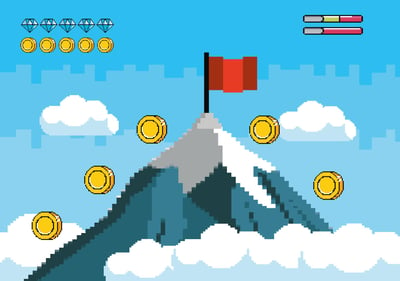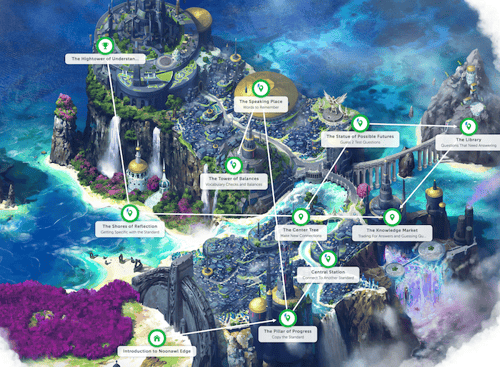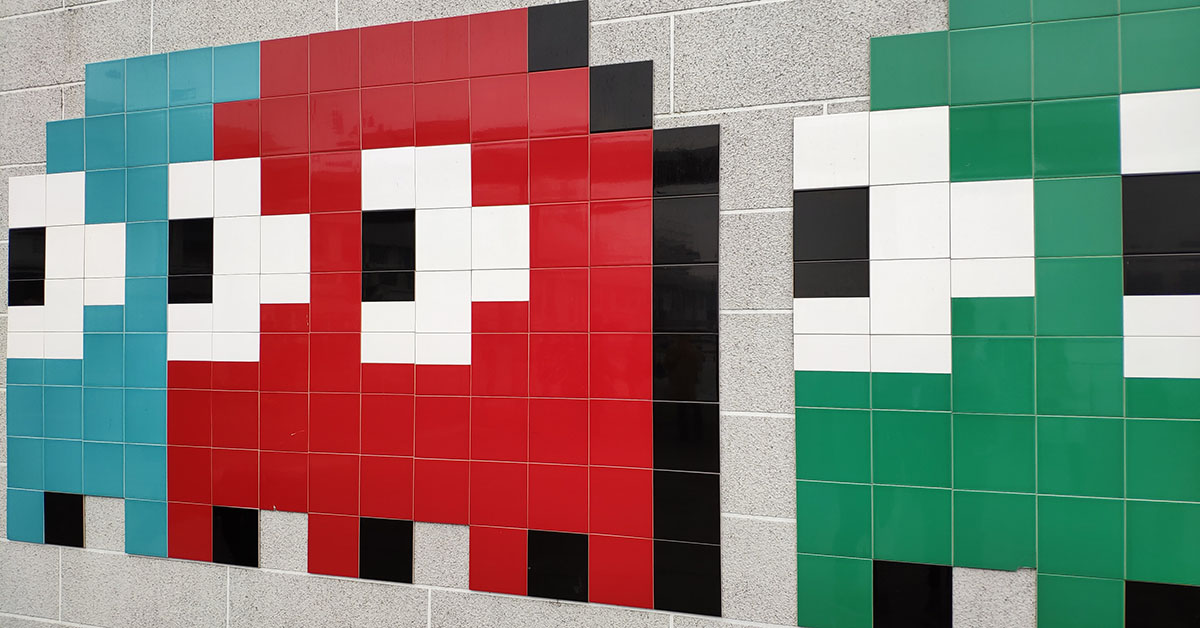Here’s our primer on gamification: what the term means, what it does to your learners’ dopamine levels(!) and how you can create gamified content in your Moodle or Totara Learn LMS.
 (Source: Stockgiu, freepik).
(Source: Stockgiu, freepik).
What does gamification mean?
Game mechanics vs game-based learning
Like many terms in eLearning, there’s more than one gamification definition. The simplest way to understand this educational strategy is to realize how ubiquitous games have become in our everyday lives—even in places where games don’t at first seem like a natural fit.
Today, game elements—points, leaderboards, progress bars, levels—can be found across software, websites, and instructional resources, from those using games to boost participation, to the most popular fitness and language apps for our devices.
Those working in educational environments will already be familiar with how the introduction of naturally motivating aspects of games—timers, competitions, quests—can boost learner engagement, and keep them coming back for more.
This is the gamification wave—the idea that integrating game mechanics into content increases enjoyment, engagement, motivation, and retention.
Terminology sticklers might separate gamification from the use of actual games in the learning space.
Strictly speaking, gamification is differentiated from game-based learning. While gamification may appear game-like, it technically only refers to the integration of game mechanics with training.
For most, though, any kind of game or game-like element used in eLearning falls under the umbrella of gamification. For the full rundown, here’s our webinar on Gamification 101 – What It Is and How to Get Started.
Why gamification works
Everyone played games at school, whether it was in the playground or on the computer. But unless you’ve recently graduated, or were lucky enough to have a forward-thinking teacher, it’s unlikely you had the chance to experience a fully gamified learning experience.
Today, the gamification of education has become a scientific, sophisticated process—hacking the brain’s natural reward mechanisms to optimize learner commitment.
By using game elements proven to up immersion and focus levels, designers are aimed at controlling the release of dopamine and related chemicals in learners’ brains. These are used by the body to carry messages between neurons, signalling that it’s time to perform an action.
Dopamine, as explained in this post on 4 essential Neurotransmitters in gamification, is released by the body in the run-up to an event, especially when it senses a novel or possibly rewarding activity on the horizon.
The chemical also contributes to the formation of mental associations between events, behaviours, and consequences, once an activity is finished.
|
Presence of novel activity ↓
Triggers dopamine
↓
Creates a higher motivational state
↓
Fuelling engagement and priming neurons
↓
Neurogenesis & increased synaptic plasticity (or in other words, learning!)
|
This trend is easy to spot across tech—just pay close attention to what’s happening inside your head the next time a message icon dings or vibrates on your device.
This is especially true of platforms designed on principles of capturing attention and repeat usage, with Facebook’s architects going as far as to call dopamine centres a vulnerability in human psychology.
Hitting these chemical centres in the right combination has the power to transform boring or repetitive work into compelling exploration, or as Nicole Lazzaro explains in her ted talk above: serious fun. Lazzaro describes successful gamified learning as encompassing Four Keys to Fun:
- Easy fun (novelty): exploration that encourages curiosity, creativity, and role play.
- Hard fun (challenge): battling for that epic win, and the euphoria of meeting a tough goal.
- People fun (friendship): friendly cooperation and competition.
- Serious fun (meaning): playing an active role in a world, leading to full immersion.
 The molecular structure of dopamine (Source: Wikicommons).
The molecular structure of dopamine (Source: Wikicommons).
Gamification in education
What is gamification in education?
Gamification and eLearning meet in an LMS, where it becomes possible to infuse all of the most motivational game mechanics with your own lesson content.
In Moodle LMS, this can be done by making use of the many Moodle plugins that are designed specifically for adding game elements to course materials.
For example, the Level Up plugin introduces experience points into the learning space, attributed to learners based on their course interactions. Points are displayed in an on-screen accumulator as learners progress towards the next level.
In Totara Learn, you’ll need an extension such as Motrain, which allows employees to earn virtual coins for completing activities. These coins can then be used in an admin-configured store to purchase bespoke items—an extra day of vacation, a free work lunch, etc.
Three main elements of gamification
|
|
1. Level-up and compete. We’ve all seen what can happen when somebody gets a little too into a competitive game, be it video games like Fornite, after-work sports, or (especially) family board games during the holidays. In a milder way, eLearning gamification aims to add in these competitive incentives, encouraging learners to become more invested in their course. A popular method for increasing personal investment is avatars. An avatar is a virtual embodiment of a user, which can then collect points, stats, badges and rewards on a user’s behalf. This is a convenient way of embedding a learner into an activity and has also been found to increase feelings of community within the online space (Anetta, 2010). |
|
2. Boost retention and motivation at key points. Sounds, symbols, icons, collectables and nudges are all ways to hack that elusive dopamine release in learners. But it’s important to point out that there’s a difference between using dopamine management to encourage engagement, and attempting to tap into users’ addictive tendencies. Many—especially mobile—games use these same game elements to keep the brains’ reward systems hijacked for minimal positive outcomes to the user, which is not the aim of eLearning! |
|
3. Developing an engaging learner journey. Many educators use eLearning to increase the sense of flow within their course. As this video on game design shows, games are a great way of introducing narrative or rhythmic patterns to content, which helps maintain a productive pace of learning. |
Points, badges, stats
In the gamified learning environment, rewards have evolved from something external received at the end of the learning journey, to an ongoing and intrinsic source of motivation.
Rewards keep learners updated on their successes, ensuring that they feel appreciated, whether they’ve reached the end of a module or simply mastered a tough activity.
digital badges are a common way of recognizing these learning milestones. Badges needn’t appear like traditional medals or patches—instead, they symbolize membership within the learning community.
Offering a set of badges to learners can act as internal and social motivation for learners, particularly if they are rare or hard to earn (Abramovich et al., 2013).
Badges also work well with other grading systems such as points or percentages. Points-based systems are great for feedback, allowing learners to see a live measurement of progress, and serving as a source of immediate positive enforcement (Sailer et al., 2013).
Stats and game data let learners know what’s happening in ways that real life just can’t match. As Eugen Eşanu writes in UX Planet, “life is so boring for many. You don’t know the progress of your efforts in months or years. In a game? After every action or quest finished, you receive a trophy.”
This kind of instant reward or direction is too enticing for may to resist. For a look at some other ways to use game mechanics to top up motivation, read our post on How to Reduce Disengagement with Gamification.
![]() Example of player (or learner) Avatars (Source: freepik).
Example of player (or learner) Avatars (Source: freepik).
The tech side of things
H5P
H5P (Html-5-Package) is a widely used plugin that supports admins designing and running interactive LMS content.
The tool works by letting designers make the most of html5, the universal code used to display web pages (competitors Flash and Silverlight provide the same service, but with less compatibility). Having control over html5 means increasing your ability to run effects and multimedia within your LMS, which is good news for those working on gamified courses.
Even if you’re not building content within an LMS, H5P is still the way to go. Because it uses a minimal Javascript code, it’s easy to embed wherever you’re working. Try this post on How To Benefit From Game-Based Learning and Gamification in eLearning for more design and admin tips, or see for yourself how H5P Makes Making Interactive Content Easy in this instructional video.
Interactive Content
With an app like H5P in your course design toolkit, it’s possible to use video game principles in content design. This might mean introducing interactive games at strategic points along the learning pathway, or including subtle mechanics across the entire course.
The real benefit of making learning content interactive is the instant feedback it gives. Animated content produces live responses, signalling learner success through badges, points, and fun animations.
 Learning quests—not just for kids (Source: classcraft.com/blog).
Learning quests—not just for kids (Source: classcraft.com/blog).
Gamification examples
Benefiting from game mechanics
Using Moodle to integrate gamified elements changes the landscape for how learning and play can be used in training. Here are some ideas for the next time you design course content:
- Progress Bar: these work well to show users where they are on their learning journey. Filling the entire progress bar gives that association-forming, rewarding feeling, encouraging the user to repeat the process.
Progress bars are more effective than numerical or statistical indicators of progress (i.e. 50% complete), simply because they’re visual. This makes understanding progress data instant and seamless.
- Quest: missions, challenges, and stories give users a set of objectives to achieve before progressing to the next stage of the learning path. A narrative can help make the process more immersive, and can consist of a single step or a long learning journey.
- Leaderboard: anything that encourages competition in your LMS is likely to naturally motivate many learners. This includes peer competition, but also competition to beat one’s own score. Multiple leaderboards can ramp up the excitement by separating teams, departments and locations, while introducing more opportunities to score highly.
One tip here is to ensure no leaderboard highlights the lowest scoring learners—tactfully ‘slicing’ your leaderboard to make it appear in the most positive light is a popular way of solving this issue.
For the details on how to track learners’ progress as they use these game elements, see our post explaining 4 Ways to Use Gamification to Measure Engagement.
(Source H5P.org).
Game-based learning
As discussed, gamification purists might discount real games from the definition of the term. But the truth is that eLearning games remain an effective teaching tool, however you choose to define them.
Take H5P’s simple, effective memory games, for instance. Using the plugin, it’s easy to supplement more traditional content with fast, fun learning games. In the game above, learners match up image pairs to reveal a key piece of content.
But there’s no one standard model for a successful eLearning game—the idea is to consider how a game takes central course concepts, and makes learning them more appealing.
If you’re looking for more expert advice and how-to content on fostering learner engagement with your courses and training programs, here’s what our eLearning experts have put together for you:
- Webinar: How to Reduce Disengagement with Gamification
- Webinar: Gamification 101 – What It Is and How to Get Started?
- Webinar: H5P - Making Interactive Content Easy
- Webinar: How to Easily Create Interactive Content in Your LMS
- Webinar: How to Easily Create Interactive Content in Your LMS 2.0
- Webinar: Creating Effective Learning Videos in 7 Easy Steps
- eBook: Attract Star Talent (And Keep Them!): Learning Paths for Employee Retention
- eBook: The All-Important E’s of eLearning: Engagement & Effectiveness
- eBook: Getting Engaged: How To Make Your Learners Fall in Love with Learning
- eBook: Using Analytics to Deliver Engaging Courses




